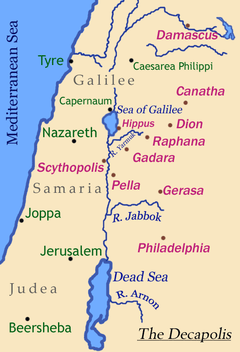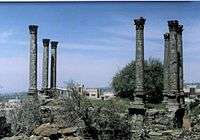Qanawat
| Qanawat قنوات | |
|---|---|
 Qanawat Location in Syria | |
| Coordinates: 32°45′20″N 36°37′00″E / 32.75556°N 36.61667°E | |
| Country |
|
| Governorate | Suwayda |
| District | Suwayda |
| Subdistrict | Suwayda |
| Elevation | 1,200 m (3,900 ft) |
| Population (2004) | |
| • Total | 8,324 |
| Time zone | EET (UTC+2) |
| • Summer (DST) | +3 (UTC) |
Qanawat (Arabic: قنوات), is a village in Syria, located 7 km north-east of al-Suwayda. It stands at a height of about 1,200 m, near a river and surrounded by woods. Its inhabitants are entirely from the Druze community.[1] According to the Syria Central Bureau of Statistics (CBS), Qanawat had a population of 8,324 in the 2004 census.[2]
History

Qanawat is one of the earliest cities in the Bashan and Hauran areas. It is probably evidenced in the bible as Kenath (Hebrew: קְנָת, Numbers 32:42, 1 Chronicles 2:23). Possible earlier evidence, is from Ancient Egyptian documents like the Execration texts (second group) of the 20-19th century BC, and the Amarna letters of the 14th century BC (as Qanu, in EA 204).[3][4]
Hellenistic and Roman history

The ancient Hellenistic-Roman city of Canatha (also Kanatha, Κάναθα in Ancient Greek), is mentioned for the first time in the reign of Herod the Great (1st century BC), when Nabatean Arab forces defeated a Jewish army. It remained an issue of contention between the two powers. From Pompey's time until Trajan's, it was a city of the Decapolis, a loose federation of cities allowed by the Romans to enjoy a degree of autonomy. In the 1st century AD it was annexed to the Roman province of Syria, and in the 2nd century it was rechristened Septimia Canatha by Septimius Severus, a Roman colony, and transferred to the province of Arabia.[5]
Bishopric
Only one of the bishops of Canatha is known by name: Theodosius took part in the Robber Council of Ephesus in 449, in the Council of Chalcedon in 451, and in a synod called by Patriarch Gennadius I of Constantinople in 459 against simony.[6][7]
No longer a residential bishopric, Canatha is today listed by the Catholic Church as a titular see.[8]
Islamic history
A center of Christianism propagation in the area, Canatha was captured by the Muslim Arabs in 637, declining in importance until, in the 9th century, it was reduced to a poor village.
In 1596 Qanawat appeared in the Ottoman tax registers as part of the nahiya of Bani Nasiyya in the Qada of Hauran. It had a Christian population consisting of 5 households and a Muslim population of 12 households; the inhabitants included a settled group of beduins. Taxes were paid on wheat, barley, summer crops, goats and/or beehives.[9]
Main sights
The city's extensive ancient ruins are 1500 m in length and 750 m in breadth. Among them are a Roman bridge and a rock-hewn theatre, with nine tiers of seats and an orchestra nineteen meters in diameter, also a nymphaeum, an aqueduct, and a large prostyle temple with portico and colonnades. North-west of the town is a late 2nd or early 3rd century peripteral temple, built on a high platform surrounded by a colonnade. For years, this temple was believed to honour Helios, but an inscription discovered in 2002 shows that it was dedicated to a local god, Rabbos.[10]
The monument known as Es-Serai (also Seraya, "palace") dates from around the 2nd century AD and was originally a temple, and then, from the 4th/5th centuries, a Christian basilica. It is 22 m long, and was preceded by an outside portico and an atrium with eighteen columns.
The German explorer Hermann Burchardt visited the town in 1895, taking photographs of its antiquities, photographs which are now held in the Ethnological Museum of Berlin.[11]
References
- ↑ Betts, 2010, p. 22.
- ↑ "General Census of Population 2004.". Retrieved 2014-07-10.
- ↑ Ewing, W (1915). "Kenath". In James Orr (ed.). International Standard Bible Encyclopedia. Retrieved 2014-05-27.
- ↑ Moran, William L, ed. (2002). The Amarna letters. The Johns Hopkins University Press. pp. 124, 391. ISBN 0801842514.
- ↑ Burns, 2009, pp. 246-247
- ↑ Michel Lequien, Oriens christianus in quatuor Patriarchatus digestus, Paris 1740, Vol. II, coll. 867-868
- ↑ Pius Bonifacius Gams, Series episcoporum Ecclesiae Catholicae, Leipzig 1931, p. 435
- ↑ Annuario Pontificio 2013 (Libreria Editrice Vaticana 2013 ISBN 978-88-209-9070-1), p. 857
- ↑ Hütteroth and Abdulfattah, 1977, p. 218.
- ↑ Burns, 2009, p. 249
- ↑ General view of Qanawat (click on photo to enlarge); Qanawat, Serail (click on photo to enlarge).
Bibliography
| Wikimedia Commons has media related to Qanawat. |
- Betts, Robert Brenton (2010). The Druze. Yale University Press. ISBN 0300048106.
- Burns, Ross (2009). The Monuments of Syria. I. B. Tauris. ISBN 0857714899.
- Hütteroth, Wolf-Dieter; Abdulfattah, Kamal (1977). Historical Geography of Palestine, Transjordan and Southern Syria in the Late 16th Century. Erlanger Geographische Arbeiten, Sonderband 5. Erlangen, Germany: Vorstand der Fränkischen Geographischen Gesellschaft. ISBN 3-920405-41-2.
External links
- Map of the town, Google Maps
Coordinates: 32°45′20″N 36°37′0″E / 32.75556°N 36.61667°E